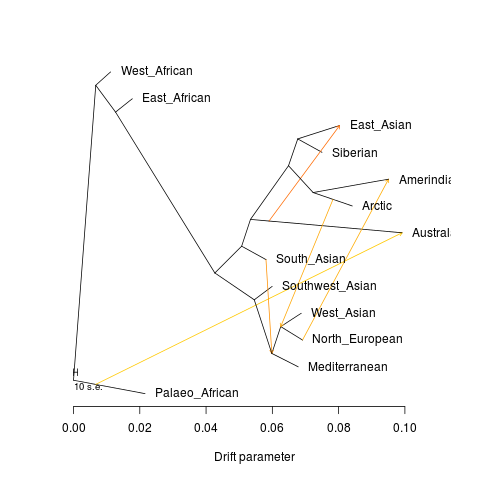Modern day indigenous populations around the world carry particular blends of nine regional affiliations:
Using a method of analysis that infers ancestral source populations, we have discovered nine ancestral regions that combine to make up everyone’s genome. Everyone has a mix of these components ranging from 0% to 100% due to interaction between these regions of the world over the past 50,000 years. Native Americans have their own group, as do Oceanians and the Khoisan people of southern Africa. In these places it is possible to have 100% of the respective region. Everyone else in the world is a mix of these components, reflecting ancient and modern migration patterns.
Northeast Asian: This component is found at highest frequencies in the populations of northeast Asia—people from Japan, China and Mongolia in our reference populations. It is also found at lower frequencies in southeast Asia and India, where it likely arrived in the past 10,000 years with the expansion of rice farmers coming from further north. Interestingly, it is also found at a frequency of 5-10% in the Finns, likely introduced by the migrations of the Saami people from Siberia into Finland over the past 5,000 years.
Mediterranean: This component is found at highest frequencies in southern Europe and the Levant—people from Sardinia, Italy, Greece, Lebanon, Egypt and Tunisia in our reference populations. While not limited to these groups, it is found at lower frequencies throughout the rest of Europe, the Middle East, Central and South Asia, due to these populations traveling through this region on their journeys and retaining that in their DNA. This component is likely the signal of the Neolithic population expansion from the Middle East, beginning around 8,000 years ago, likely from the western part of the Fertile Crescent.
Southern African: This component is found at highest frequency in the Khoisan people of southern Africa—the famous ‘Bushmen of the Kalahari.’ It likely represents the earliest split in the human population in Africa, before we left to colonize the rest of the world, more than 100,000 years ago. These early southern Africans were once more widespread, accounting for the low frequency of this component in other African populations.
Southwest Asian: This component is found at highest frequencies in India and neighboring populations, including Tajikistan and Iran in our reference dataset. It is also found at lower frequencies in Europe and North Africa. As with the Mediterranean component, it was likely spread during the Neolithic expansion, perhaps from the eastern part of the Fertile Crescent. Individuals with heavy European influence in their ancestry will show traces of this because all Europeans have mixed with people from Southwest Asia over tens of thousands of years.
Native American: This component is found at highest frequency in the populations of the Americas. It represents the signal of the original settlers of North and South America who arrived via the Bering land bridge between 15-20,000 years ago. Interestingly, the only other place in the world where it is found—at frequencies of 2-3%—is in central Siberia and Mongolia, the likely place of origin of the first Native Americans.
Oceanian: This component is found at highest frequencies in Near Oceania—people from Papua New Guinea and Melanesia in our reference populations. It is also found at much lower, but still detectable, frequency in populations from eastern India, reflecting a small degree of migration between these regions. It is likely a signal of the earliest coastal migrants to Near Oceania, who arrived in the region around 50,000 years ago.
Southeast Asian: This component is found at highest frequencies in the populations of southeast Asia and India, particularly in the northeast Indian and Vietnamese populations in our reference set. It is also found at lower frequency in populations from Oceania, where it persists as a signal of the Austronesian migrations into the region beginning ~5,000 years ago—a migration that would eventually colonize Polynesia. Interestingly, it is also found in the population of Madagascar, brought there by the seafaring Austronesians around 2,000 years ago.
Northern European: This component is found at highest frequency in northern European populations—people from the UK, Denmark, Finland, Russia and Germany in our reference populations. While not limited to these groups, it is found at lower frequencies throughout the rest of Europe. This component is likely the signal of the earliest hunter-gatherer inhabitants of Europe, who were the last to make the transition to agriculture as it moved in from the Middle East during the Neolithic period around 8,000 years ago.
Sub-Saharan African: This component is found at highest frequency in the people of sub-Saharan Africa, particularly among those speaking Bantu languages such as the Yoruba and Luhya in our reference populations. It likely represents a signal of the original inhabitants of eastern and central Africa, and was spread in part due to the migrations of the Bantu speakers throughout Africa in the past 2,500 years. It is also found at lower frequencies north of the Sahara, in populations such as the Tunisians and Egyptians.




















